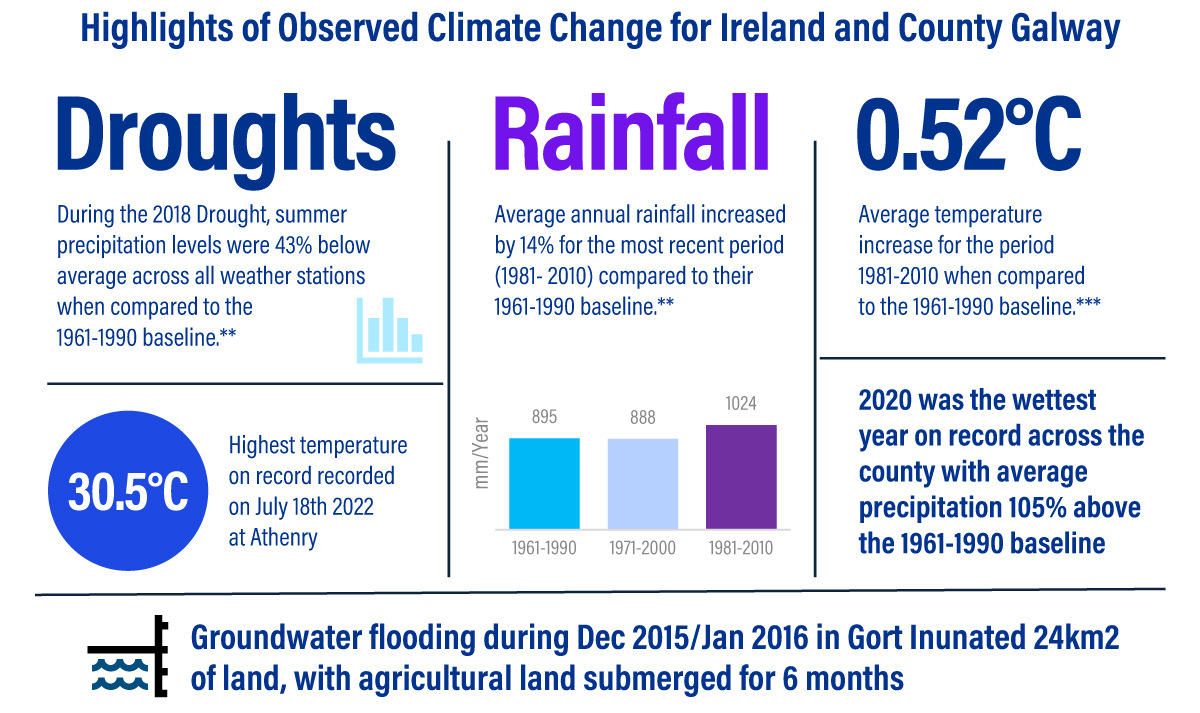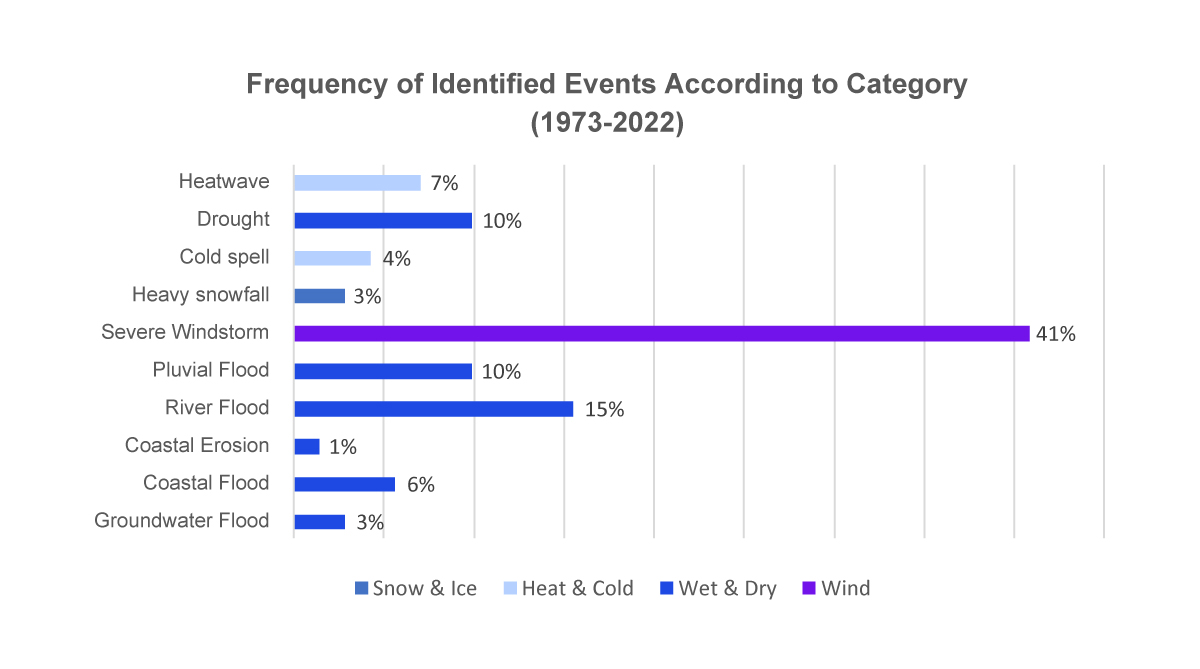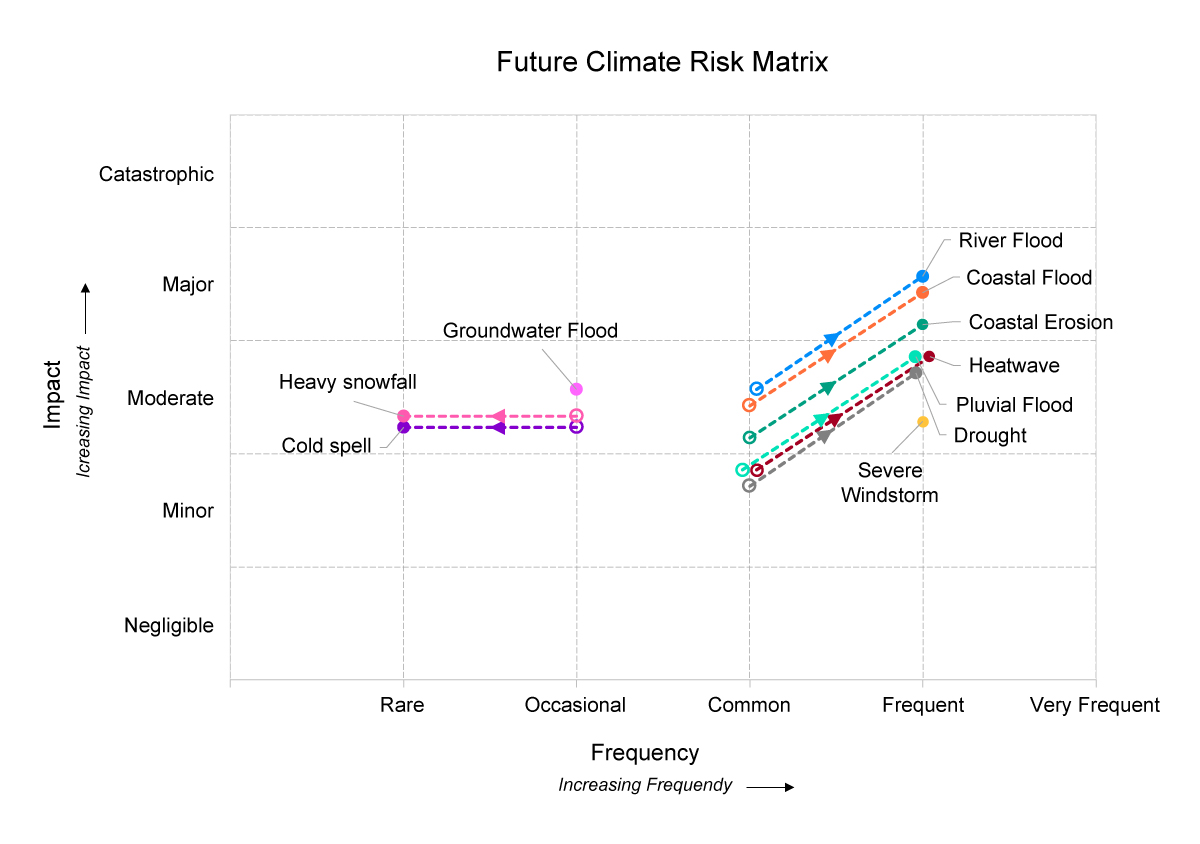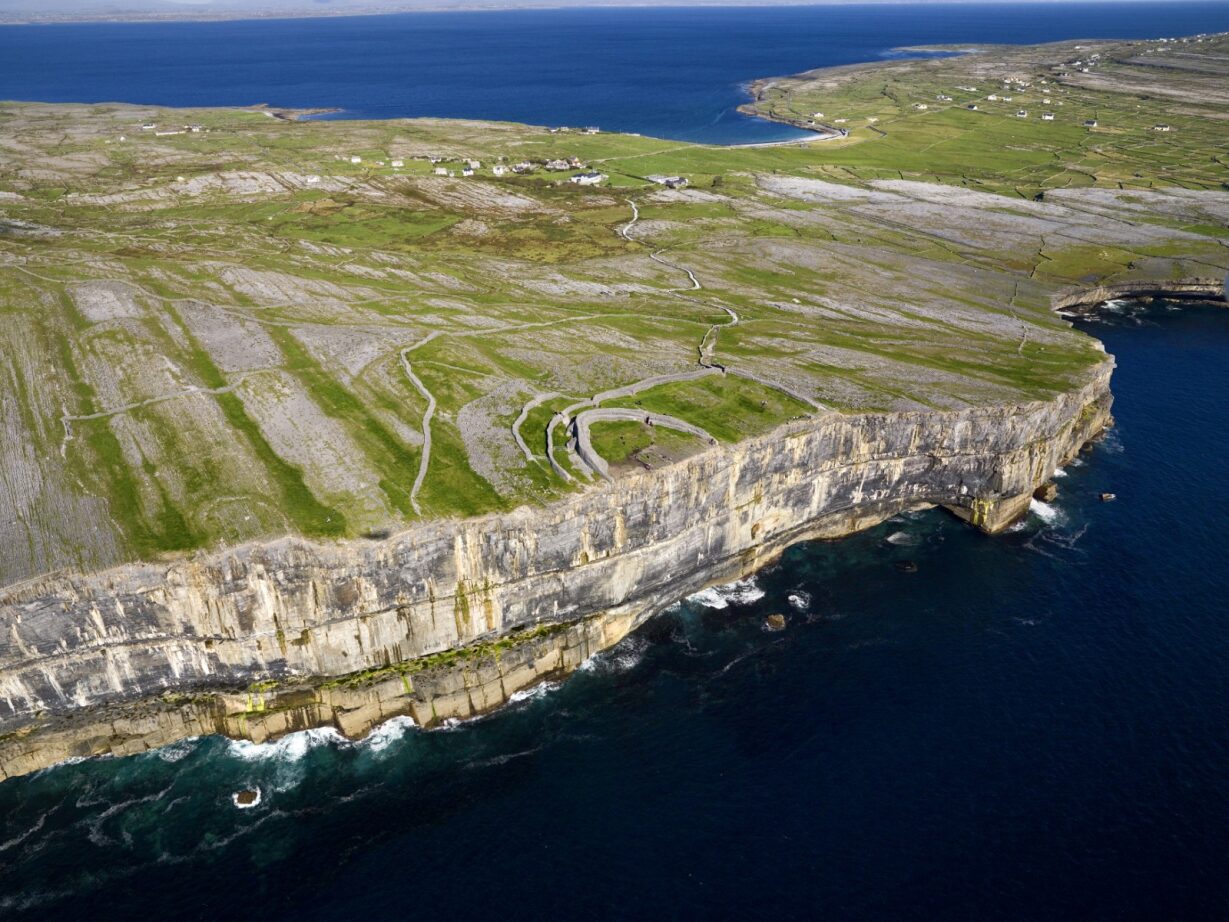2. Climate Change Overview
2.1. Scientific Context of Climate Change
2.1.1. Global Climate Change
Climate change is increasingly understood to be the most critical, long-term global challenge of our time, its impacts continue to be felt both worldwide and at home. Climate change risk assessments identify the likelihood of future climate hazards and their potential impacts. This is fundamental for informing the prioritisation of climate action and investment in climate action. The Intergovernmental Panel on Climate Change (IPCC’s) Working Group Sixth Risk Assessment Report, confirms that there is overwhelming evidence that the climate has changed since the pre-industrial era and that human activities, through greenhouse gas emissions, are the principal cause of that change. It states the unequivocal cause of global warming has been human activities, with global surface temperatures reaching 1.1°C above 1850-1900, in the 2011-2020 period.
A warming climate has caused a rise in sea level, through the loss of sea ice and thermal expansion (the increase in the volume of water due to heating) resulting from the warming ocean. Global mean sea level increased by 20 cm between 1901 and 2018. The trend in global mean sea level rise has been consistently rising since 1901.
2.1.2. Climate Projections for Ireland
Ireland’s temperate has increased in line with global temperature increases, with 2022 being a year of record-breaking extremes, in both temperature and rainfall. Ireland’s temperature has been above the long-term average for 12 consecutive years and there has been a rise in sea level in line with global increases, with an average of 2-3 mm per year.
Recent extreme weather events have highlighted the vulnerability of individuals, businesses, communities and infrastructure to climate change, emphasising the need for urgency on climate action across all sectors of society. The adverse impacts of climate change can often compound wider reaching social, environmental and economic challenges. This can increase vulnerability and sensitivity to a changing climate and climate extremes.
Based on observed changes in climate and its impacts, climate scientists can make robust projections on future climate patterns in Ireland. Future climate projections were set out in The Status of Ireland’s Climate Report, July 2021 and can be summarised as follows:
- Climate trends observed over the last century will continue and intensify over the coming decades.
- Temperatures are increasing and are expected to continue to increase across all seasons.
- Significant reductions in levels of average rainfall are expected in Spring and Summer with increased occurrence of extreme rainfall events, particularly in Winter.
- The frequency of extreme wind conditions is expected to increase, particularly during Winter.
- An increase in sea level rise, similar to what has been experienced to date. Ireland is extremely vulnerable to sea level rise, due to its expansive coastline and the large population on the coast.
- Increases in the frequency of river and surface water flooding.
- Increases in the frequency and intensity of coastal flooding and erosion.
- Increases in the frequency and intensity of summer heat waves, extreme temperatures and drought.
- Reductions in the frequency of frost and snowfall.
- An increase in the duration of the growing season (phenological cycle).
The state of Ireland’s climate today and how it may look in the future can be brought together in one simple conclusion. Ireland’s climate has changed relative to the 1900’s, it has undoubtedly warmed along with global temperatures, bringing about an array of impacts that are associated with a warmer climate and more extreme weather events.
2.1.3. Risk Assessment for the County of Galway
2.1.3.1. Purpose of Climate Change Risk Assessments
Risk Assessment is a crucial component of climate action planning process, as it helps to identify the potential risks and vulnerabilities that climate change poses, and to identify appropriate measures (actions) to mitigate them. To understand how Galway County Council needs to adapt to observed and projected changes in climate, KPMG supported Galway County Council to build a Climate Change Risk Assessment (CCRA).
2.1.3.2. Climate Change Projections
Projecting future climate change involves assessing several different uncertainties. Scenarios, called Representative Concentration Pathways (RCPs) have been developed to simulate how the climate might change in the future in response to different levels of greenhouse gases. In assessing climate change risk for County Galway, information for two future climate scenarios were employed, RCP4.5 and RCP 8.5. The RCP8.5 scenario was used as it represents a ‘worst-case’ scenario which allows for a conservative risk assessment approach.
RCP4.5Represents an ‘intermediate emissions’ scenario with an average global warming of 1.4°C for the 2046-2065 period. |
RCP8.5Represents a ‘very high emissions’ scenario with an average global warming of 2°C for the 2046-2065 period. |
2.1.3.3. Observed Climate Changes for the County of Galway
In line with global trends, the climate of Ireland and Galway is changing, temperatures are increasing, and patterns of precipitation are changing. A summary of key climate and weather-related changes already observed for the County of Galway are detailed below.
 Figure 2.1: Synopsis of observed changes in the County of Galway from 1961 to 2022
Figure 2.1: Synopsis of observed changes in the County of Galway from 1961 to 2022
For each climate hazard identified through the climate hazard profile, an assessment of frequency of occurrence was conducted. Severe storm events were identified as the most significant climate hazard over the period 1973-2022, with river and pluvial flooding, heatwaves and drought, coastal erosion and flooding also affecting the County on a number of occasions. Cold spells, heavy snowfall and groundwater flooding, have also impacted County Galway, but less frequently.
Figure 2.2: Frequency of Identified Events
A comprehensive summary of the information that underpins the exposures, vulnerabilities and impacts for the hazards that exist within the County of Galway was detailed in the Climate Change Risk Assessment Technical Report.
2.1.3.4. Climate Projections for the County of Galway
Having identified and assessed the range of climate hazards already experienced in the County of Galway, the projected changes in the frequency and intensity of climate hazards was assessed to understand how existing climate impacts and risks faced by Galway County Council may look in the future.
In line with global trends, the frequency and intensity of some hazards (e.g. coastal, river and surface water flooding, coastal erosion, heatwaves and drought) will increase while others (e.g. severe windstorms) will remain the same. These changes are projected to continue and intensify with a wide range of impacts for the County of Galway.
|
Hazard |
Projected Change |
Future Frequency |
|---|---|---|
|
Heatwaves |
|
Frequent |
|
Droughts |
|
Frequent |
|
Cold Spell |
|
Rare |
|
Heavy Snowfall |
|
Rare |
|
Severe Windstorms |
|
Frequent |
|
Coastal Flooding |
|
Frequent |
|
Coastal Erosion |
|
Frequent |
|
Pluvial Flooding River Flooding |
|
Frequent |
|
Groundwater Flooding |
|
Occasional |
Table 2: Change in Frequency of Climate Hazards in the County of Galway

Figure 2.3: The County of Galway Climate Risk Matrix
National, regional and local strategies that outlined expected and possible sociodemographic and infrastructure developments within the County of Galway were reviewed to understand how exposure and vulnerability may change by 2050.
The Risk Assessment was developed based on the most-up-to-date climate projection data available at the time of writing. The underlying models are updated on a regular basis and the level of risk may increase as a result. In addition, feedback loops, which would likely make the effects more impactful, could not be considered, due to a lack of local modelling. Other indirect risks from climate change, while not part of this Risk Assessment, should be noted, such as forced migration of populations, increases in vector-borne disease and disruption of supply chains. The Climate Risk Assessment Report can be viewed here.
2.2. Legislative and Policy Context
Climate action is given impetus by the scientific evidence that supports the findings of human influence on climate change and legally binding ambitious and strengthened policy responses. Consequently, this Climate Action Plan is set within a broader context of international, EU, national and sectoral climate policy.

Figure 2.4: (Source: Climate Action Regional Offices)
2.2.1. Global
It has been recognised that successfully tackling climate change requires cooperation and ambition on an international level. Countries have sought to build international cooperation to limit the increase in the average global temperature and deal with the impacts of climate change.
Paris Agreement
These efforts led to the signing of the Paris Agreement 2015 by all 196 UN member countries in November 2016. This is a legally binding international treaty which strives for progressive and ambitious climate action over time to avoid dangerous climate change by holding global warming to well below 2°C and seek to limit the temperature increase by 1.5°C, in comparison to pre-industrial levels. It also seeks to increase the ability to adapt to the adverse impacts of climate change and foster climate resilience.
Agenda 2030 for Sustainable Development and Sustainable Development Goals
The 2030 Agenda for Sustainable Development was adopted by UN Member States in September 2015. At the Agenda’s core are 17 Sustainable Development Goals (SDGs) . These goals aim to “end poverty, protect the planet and improve the lives and prospects of everyone, everywhere.” The 17 SDGs contain 169 targets to be achieved by 2030. In 2019, World leaders called for a ‘decade of action’ to achieve the Goals within this timeframe.
The 17 Sustainable Development Goals (SDGs), are an urgent call for action by all countries - developed and developing - in a global partnership. They recognise that ending poverty and other deprivations must go hand-in-hand with strategies that improve health and education, reduce inequality, and spur economic growth – all while tackling climate change and working to preserve our oceans and forests. Each action within this Climate Action Plan is aligned to at least one SDG.

The SDG National Implementation Plans acknowledge that local government “has a crucial role to play in translating national policies into tangible practical actions that can help to concretise the SDG objectives into our individual and communities’ behaviours and goals.”
Galway County Council is working to advance the SDGs, through the incorporation of the SDGs into our plans and policies, participation in local and international partnerships and the provision of training and information events both internally and externally.
To understand and maximise the alignment between the actions in this Plan and the SDGs, a mapping assessment has been conducted. This supports our understanding of the co-benefits of the actions including benefits to livelihoods, economic growth, gender equity, and health and well-being.
2.2.2. European
European Union Green Deal (2020)
In December 2019, the European Union announced the European Green Deal aimed at making Europe the first climate neutral continent. The Deal seeks to achieve no net emissions of greenhouse gases by 2050, to decouple economic growth from resource use, and to leave no one behind.
European Climate Law
The EU introduced a set of proposals to align the EUs climate, taxation, energy, and transport policies to support achieving this aim. The European Climate Law 2021 made these targets legally binding with an intermediate target of reducing net GHG emissions by at least 55% by 2030.
EU Fit for 55
EU Fit for 55 is a package that aims to bring the EU’s climate and energy legislation in line with the 55% GHG emission reduction target set by the EU for 2030.
2.2.3. National
Climate Action and Low Carbon Development (Amendment) Act 2021
Climate change policy in Ireland now reflects the ambition of the EU. The Climate Action and Low Carbon Development (Amendment) Act 2021 frames Ireland’s legally binding climate ambition to delivering a reduction in GHG emissions of 51% by 2030, and to achieve climate neutrality by the end of 2050. The Act aims to provide for the approval of plans by the Government in relation to climate change for the purpose of pursuing the transition to a climate resilient, biodiversity rich and climate neutral economy by no later than the end of the year 2050. The Act enshrines the National Climate Objective to “pursue and achieve, by no later than the end of 2050, the transition to a climate resilient, biodiversity rich, environmentally sustainable and climate neutral economy.”
Local Authority Climate Action Plans
A key element of the Climate Action and Low Carbon Development Act (Amendment) 2021 relevant to all local authorities is the requirement for all local authorities to prepare an individual Local Authority Climate Action Plan (LACAP) for their functional area. The purpose of the LACAP will be to deliver effective climate mitigation and climate adaptation actions at local authority and community levels. Local Authority Development Plans must also be aligned with their LACAP. Local authorities are well positioned at the forefront of climate action in Ireland, and play a significant role in terms of delivering adaptation and mitigation measures at local and community levels. We are entrusted to work through our regulatory and strategic functions to operationalise the ambitious national climate targets and policy at local levels, to assist in the delivery of the National Climate Objective.
National Climate Action Plans
The 2023 Climate Action Plan outlines the challenges across key sectors including electricity, transport, built environment, industry, and agriculture. The Plan outlines the final agreed emissions reduction targets for each of the key sectors. The GHG emissions reduction targets in the 2023 Plan include: 75% reduction from electricity generation, 40% reduction from the residential sector, 45% reduction from commercial/public sector, 50% reduction from the transport sector, 25% reduction from the agriculture sector, 35% reduction from industry. A reduction target for land use, land use change and forestry (LULUCF) has yet to be determined.
The 2023 Climate Action Plan reaffirmed two high-level targets for public bodies that had been originally introduced in previous iterations of the National Climate Action Plan:
- The public sector must improve its energy efficiency by 50% by 2030, based on a 2009 baseline.
- The public sector must reduce its GHG emissions by 51% by 2030, based on a 2018 baseline.
2.2.4. Sectoral
National Adaptation Framework (NAF)
Ireland published its first National Adaptation Framework (NAF) in 2018, to assist key sectors to assess the risks of climate change, implement climate resilient actions, and ensure climate adaptation considerations are mainstreamed into national, regional and local policy making. Sectoral Climate Adaptation Plans have been published across Government departments, in response to the National Adaptation Framework. Each Plan identifies the key risks faced across the sector and the approach being taken to address these risks and build climate resilience for the future. The Plans address the following sectors: Agriculture, Forestry and Seafood, Biodiversity, Built and Archaeological Heritage, Transport infrastructure, Electricity and Gas Networks, Communications Networks, Flood Risk Management, Water Quality and Water Services Infrastructure and Health.
Climate Action Charter
The Local Authority Climate Action Charter, signed by Galway County Council in October 2019, represents a commitment to scale up efforts and play a key role locally and nationally in delivering effective climate action. It tasks all local authorities with providing robust leadership in advancing climate action at regional and local levels, with adhering to the UN SDGs, in particular Goal 13 Climate Action, as well as reducing emissions from their own operations and to collaborate and partner with local enterprise, community groups, citizens as well as public, private, and educational sectors on climate action initiatives.
Delivering Effective Climate Action 2030
Delivering Effective Climate Action 2030 (DECA 2030) is the local government strategy on climate action published in April 2021. The strategy represents an overarching sectoral commitment to ensuring a coherent approach to climate action across the administrative and political structures of all 31 local authorities. At a sectoral level the strategy communicates a general strategic intent through an envisaged leadership position, to engage the local authority network in effective climate action. Within the sector, the overall strategy represents a top-level consensus on the approach to climate action and a strong commitment to the prescribed leadership role. The strategy is a stated roadmap for local authorities in delivering the required decarbonisation and adaptation responses to climate change.
Climate Action, Transport, Circular Economy, and Networks Committee
The County and City Management Association (CCMA) is the ‘representative voice’ of the local government management network. The CCMA operates through several established committees, each of which is concerned with a specific policy area. Each Committee is made up of county and city council chief executives and directors of service / heads of finance which interface with senior management of government departments and other relevant organisations. The relevant committee in this area is the Climate Action, Transport, Circular Economy, and Networks Committee.

Photo courtesy of Chris Hill Photography
Climate Action Regional Offices
The Climate Action Regional Offices (CAROs) were initially established in 2018 to support the preparation and delivery of the Local Authority Climate Change Adaptation Strategies, to enable engagement across sectoral climate adaptation plans, and to coordinate climate action undertaken by the sector. The CAROs provide guidance, advice, and support to local authorities to leverage the capability, reach, and resources of the sector to effectively address climate change across Ireland. Galway County Council is part of the Atlantic Seaboard North region.
Galway County Development Plan
The Galway County Development Plan 2022 to 2028 sets out the overall strategy for the proper planning and sustainable development of the County over a 6-year period. Climate action is integrated into every chapter and strategy in the Plan. To facilitate the sustainable growth of renewable energies a Local Authority Renewable Energy Strategy (LARES) was prepared as part of the County Development Plan. The LARES outlines the potential for a range of renewable energy resources and developments and acknowledges the significant contribution that they can make to the county in terms of energy security, reduced reliance on traditional fossil fuels, enabling future energy exports, meeting assigned national targets and the transition to a low carbon economy.
